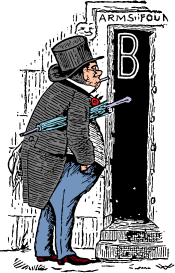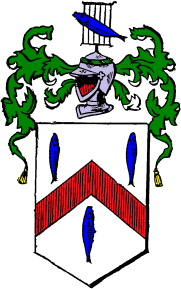HOME
Preface
Introduction
1
2
3
4
5
6
7
8
9
10
11
12
13
14
15
16
17
18
19
20
21
22
23
XV
CHAPTER XV.
OF CRESTS.
ESIDES the coronets, crowns, and chapeaux, there are other external ornaments used in Heraldry, and the most important of these is the Crest. Let us, however, commence in the orthodox manner, and in the regular didactic fashion.
The word "crest" is derived from the Latin word crista, a comb, and was worn by warriors on the tops of their helmets. As the fightingmen who appeared in helmets,--and they all did it, naturally not being desirous of having their nuts too easily cracked,--strove to be cocks of the walk, it was to be expected that they would assume a comb : besides, its connection with a brush with the enemy must of course be obvious, to say nothing of the way in which they used to show their teeth to one another.
Originally, Crests were only carried by commanders, who were thus distinguished in battle, in order to prevent their being extinguished, just on the same principle as the cognizances on the shield.
The first Crest extant, is found on the great seal of Richard Cceur de Lion, and as both his friends and foes often found him a man much given to whacks, it is to be presumed that the seal made a great impression upon them.
Crests came into general use about the time of Henry III., in whose reign that now popular entertainment, the House of Commons, may be said to have originated.
In the present day, everybody who is somebody, and a great many who are nobodies, sport Crests, and very often with about as much right to them as a dromedary has to a frock coat.
The coats of arms of ladies are not surmounted by Crests, although in private life combs are often to be met with above their coats, or, we should say, dresses. Perhaps the nearest approach to a Crest in feminine adornments, is the chignon, though we doubt much if Sir Albert Woods would be inclined to admit that as a true Crest.
Crests are composed of all kinds of articles--arms, legs, heads, tails, and bodies of men and animals, to say nothing of such trifles as hatchets, towers, gates, or in fact any other thing or person that the exuberant taste or fancy of the wearer might suggest. When discussing the Heraldic Charges, we endeavoured to show to what extraordinary lengths heraldic imagination would travel, and the same remarks apply equally to Crests, so that it is impossible to classify them with any degree of accuracy, and, as it is impossible, we are not going to try. Nevertheless, we will just give our readers five heads, under which, as a rule, they may place the origin of most Crests. This will be a contradictory process to a certain extent, as in general the comb or crest is placed upon the head, but we shall place the comb or crest under it.
Firstly: sometimes a ferocious animal, such as a lion, a tiger, or a bear, was used as a Crest, and these were assumed to denote the peculiarly unpleasant or savage qualities of the original bearer--such as a propensity catawampously to chaw up his enemies on the smallest or no provocation.
Secondly: Devices also were adopted to perpetuate feats of chivalry. Thus, if a knight had vowed to fight three other knights with his left foot tied under his right ear, (they did such foolish things in those times that nothing was too absurd for them to attempt,) and successfully performed his vow, he would probably ever after have worn a foot with a rope round it as his Crest, to perpetuate how extensive an idiot he had been on that occasion. On the same principle in the present day, when an inebriated draper's assistant, coming from the Pig and Whistle, successfully smashes a gas lamp without being taken up by the police, he might, should his selection be sanctioned by the Herald's College, adopt a "gas lamp frangant proper" as his Crest.
Thirdly: Occasionally the most prominent charge in the shield was used as a Crest--as when three potatoes baked, or three herrings pickled, are the chief cognizance of a shield, one of them would, in default of any other Crest, be adopted as such.
Fourthly: In commemoration of religious, which are often quite as stupid as chivalric, vows, Crests were assumed. Thus, a pilgrim to the Holy Land would wear a scollop shell in his helmet, which, to modern ideas, engenders thoughts of oysters; and as pilgrims were frequently what we should call a fishy lot, this device was not altogether inappropriate.
Fifthly: In sheer whims originated many Crests; and when we reflect upon the exceeding varieties of whimsicality existing in this world, the extent to which this source must have given rise to Crests is positively appalling in the wideness of the field it opens to our view. So that all those Crests which cannot be traced to any exact origin must come under this head, and it may serve us instead of the wellused but slightly vague expression, et cætera, et cœtera.
Before saying good-bye to the Crest, it will not be out of place to mention the wreath upon which it stands. This wreath is composed of different colours, generally those chiefly predominating in the shield. It is also sometimes called the "Torce," which name may,--we do not speak with any certainty,--have arisen from the fact that it was a toss up whether the wearer carried his head and Crest out of battle or not.
XV
1
2
3
4
5
6
7
8
9
10
11
12
13
14
15
16
17
18
19
20
21
22
23
Preface
Introduction
HOME
Build: 2019/04/20 14:20:08.59+0900(JST)



